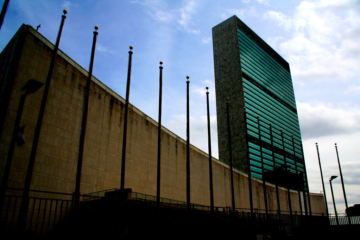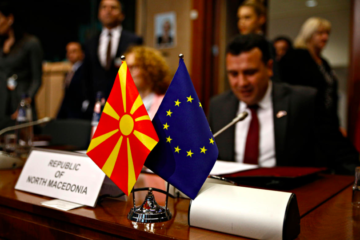A life size statue of Bruce Lee might seem like a strange choice for a park in Mostar, an Ottoman built frontier town in Bosnia and Herzegovina dating back to the fifteenth century.
Spending time in Mostar this Summer, I quickly learned the decision to commemorate Bruce Lee was a consequence of internal tensions which have dominated Bosnian politics since the end of the brutal 1992-1995 war.
Bruce Lee is one of the only figures who could be agreed upon as both aspirational and politically neutral by local authorities.
(A life sized statue of Bruce Lee in Mostar’s City Park)
In 1992 Bosnia and Herzegovina was ripped apart by war after voting for Independence from Yugoslavia in the 1991 referendum. Yugoslav forces occupied the country, relying on support from Serb-Bosnians in an effort to prevent the break-up of Yugoslavia.
Croat-Bosnians and Muslim Bosniaks allied to fight off the Serb and Yugoslav forces until 1993 when Croatia tried to annex Croat majority regions of Bosnia. At this point swathes of Croat forces turned against their former allies.
100,000 people are estimated to have been killed and more than 2,000,000 people displaced in a campaign of genocidal violence predominantly directed at Muslim Bosniaks. The war came to an end in 1995 after NATO began air strikes against Bosnian-Serb forces leading to Croat, Serb and Bosniak leaders signing the Dayton peace accord in Paris.
The conflict has left Bosnia and Herzegovina with deep social divisions and a crippling political infrastructure which a local described to me as a ‘political Frankenstein.’
It is hard to think of a better phrase to capture the frictions of a political system cobbled together by 14 parliaments, three presidents and two main electoral regions split between the majority Serb Republic of Srpska and the majority Bosniak Federation of Bosnia and Herzegovina.
Every four years the federation of Bosnia and Herzegovina elect Croat and Bosniak Presidents while the Republic of Srpska elects a Serb representative. The three leaders rotate for a four-year electoral term in which each president assumes the helm of government for 8 months at a time.
(The suburbs on the West side of Mostar)
This electoral system maintains an uneasy peace: in Mostar, bullet-ridden buildings attest to the violence of former conflict and serve as a reminder of persisting tension amongst the community.
In 1992 Serb forces lay siege to the city and from May 1993 Croat forces began a year long siege of the city. By 1995, 40,000 people had left the city and 70 percent of the buildings had been damaged or destroyed. Muslims living in areas of the town controlled by Croat forces were sent to concentration camps at Dretelj, Gabela and Heliodrom.
Hidden in the suburbs on the West side of town the old front line continues to mark a division between the majority Muslim and majority Croat areas of Mostar. I’m told that it’s predominantly the homes of Muslim Bosniaks which still bear bullet holes rather than the homes of Croats.
(An apartment block on the Bosniak’s side of the former front-line)
While it’s hard to assess the validity of these claims, they are indicative of resentment felt by Muslim Bosniaks towards Croats. Croatia has enjoyed steady economic growth since joining the EU in 2013 and the Croatian government is Bosnia and Herzegovina’s second biggest source of Foreign investment with 3.5 million euros committed to supporting Bosnian Croats in 2019.
By contrast, Muslim survivors of the Bosnian genocide feel left behind. Unemployment in Bosnia and Herzegovina is amongst the highest in the world according to Trading Economics, with a staggering 60% of young people out of work. As a result, Bosnia’s population is shrinking with swathes of young people choosing to make a life elsewhere.
(Locals walk past a bullet-ridden building in Mostar)
A building known as the ‘sniper tower’ is indicative of Bosnia and Herzegovina’s economic decline. Before the war, the building was a bank in Mostar’s bustling commercial centre. Today the crumbling building draws only intrepid tourists and the former town centre is deserted.
(Graffiti covering the walls of the ‘sniper tower,’ a building which was a bank before the war)
During the war, this sniper’s nest housed mercenaries who flocked to Mostar from all over Europe to join the campaign of violence against Muslim Bosniaks. Walking inside is an eerie experience: glass crunches underfoot and graffiti drawings of swastikas, clowns and political slogans cover the walls.
Positive messages are less frequent. Yet, amongst the more violent images I found a poem scrawled in a stairwell next to a pair of impassive eyes. The poem adjures its reader to be vigilant against divisive politics and warns against forgetting past violence perpetrated in Mostar.
The writing beneath the poem ‘želim da si Zauvijek tu’ translates from Croatian to ‘I wish you were here forever,’ perhaps intended as a universally welcoming message.
(Graffiti and a poem found in the stairwell of the sniper tower)
The end of any war is a process: decades after fighting has ceased in Bosnia the sharp decline in intermarriage suggests that ethnic divisions have been hardened by constitutional and socio-economic segregation. In Mostar, the old front line continues to mark a boundary between the majority Muslim East and majority Croat West sides of town.
Mostar is perhaps most famous for its bridge, built in 1566 by the Ottoman rulers of the town. It was destroyed during the war by Croat forces and replaced by a replica in 2004. Nowadays, it is often mistaken for the former front-line dividing Croat and Bosniak forces during the war.
Rather than a dividing line, however, the bridge offers hope that shared spaces and practices can knit society back together.
It is considered a right-of-passage for men to dive from the top of the 25m bridge into the water below, a practice which was defiantly continued during the war despite the risk of shelling. Visiting Mostar in August I joined crowds drawn from all over the city to watch a cliff diving competition together from the riverbank.
The old bridge area is a testament to Mostar’s multicultural past with Ottoman, pre-Ottoman, European and Meditteranean architectural influences. Rebuilding the bridge may not have healed the rifts within Mostar, but it sends the message that a past of co-constitution, cooperation and dependence between differing cultural groups who made their home in Bosnia and Herzegovina cannot be easily erased.
(A man prepares to dive from Stari Most (the Old Bridge) into the Neretva river)


